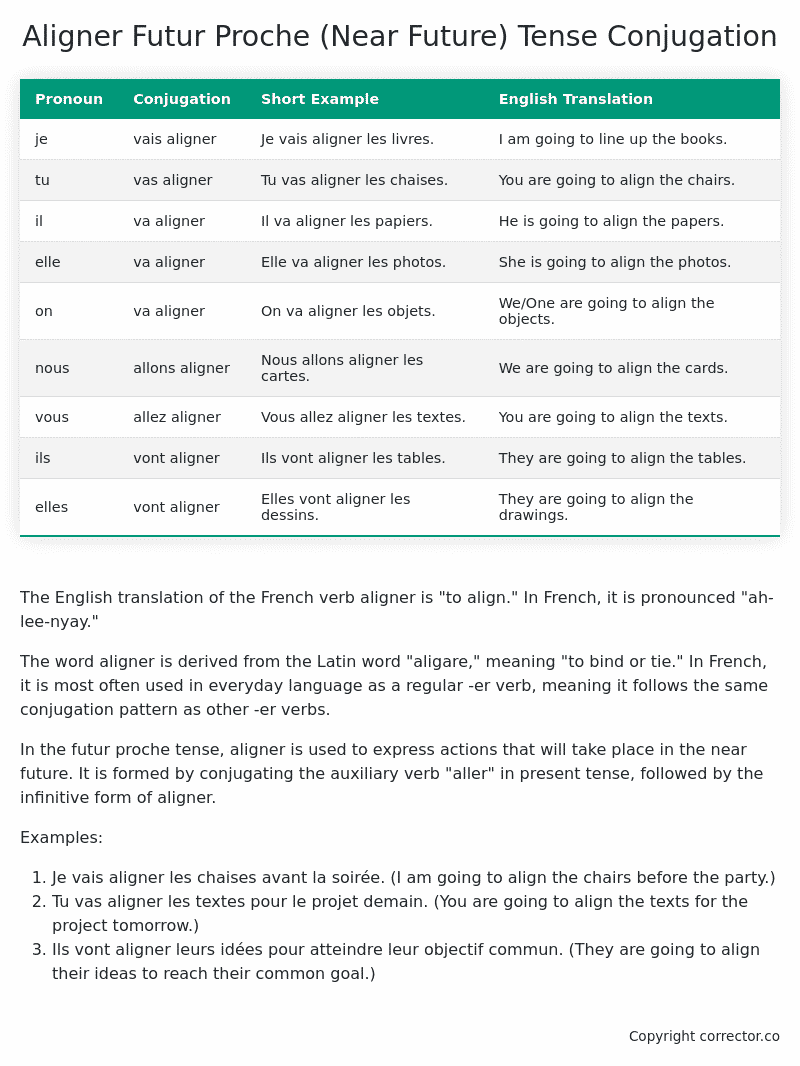Futur Proche (Near Future) Tense Conjugation of the French Verb aligner
Introduction to the verb aligner
The English translation of the French verb aligner is “to align.” In French, it is pronounced “ah-lee-nyay.”
The word aligner is derived from the Latin word “aligare,” meaning “to bind or tie.” In French, it is most often used in everyday language as a regular -er verb, meaning it follows the same conjugation pattern as other -er verbs.
In the futur proche tense, aligner is used to express actions that will take place in the near future. It is formed by conjugating the auxiliary verb “aller” in present tense, followed by the infinitive form of aligner.
Examples:
- Je vais aligner les chaises avant la soirée. (I am going to align the chairs before the party.)
- Tu vas aligner les textes pour le projet demain. (You are going to align the texts for the project tomorrow.)
- Ils vont aligner leurs idées pour atteindre leur objectif commun. (They are going to align their ideas to reach their common goal.)
Table of the Futur Proche (Near Future) Tense Conjugation of aligner
| Pronoun | Conjugation | Short Example | English Translation |
|---|---|---|---|
| je | vais aligner | Je vais aligner les livres. | I am going to line up the books. |
| tu | vas aligner | Tu vas aligner les chaises. | You are going to align the chairs. |
| il | va aligner | Il va aligner les papiers. | He is going to align the papers. |
| elle | va aligner | Elle va aligner les photos. | She is going to align the photos. |
| on | va aligner | On va aligner les objets. | We/One are going to align the objects. |
| nous | allons aligner | Nous allons aligner les cartes. | We are going to align the cards. |
| vous | allez aligner | Vous allez aligner les textes. | You are going to align the texts. |
| ils | vont aligner | Ils vont aligner les tables. | They are going to align the tables. |
| elles | vont aligner | Elles vont aligner les dessins. | They are going to align the drawings. |
Other Conjugations for Aligner.
Le Present (Present Tense) Conjugation of the French Verb aligner
Imparfait (Imperfect) Tense Conjugation of the French Verb aligner
Passé Simple (Simple Past) Tense Conjugation of the French Verb aligner
Passé Composé (Present Perfect) Tense Conjugation of the French Verb aligner
Futur Simple (Simple Future) Tense Conjugation of the French Verb aligner
Futur Proche (Near Future) Tense Conjugation of the French Verb aligner (this article)
Plus-que-parfait (Pluperfect) Tense Conjugation of the French Verb aligner
Passé Antérieur (Past Anterior) Tense Conjugation of the French Verb aligner
Futur Antérieur (Future Anterior) Tense Conjugation of the French Verb aligner
Subjonctif Présent (Subjunctive Present) Tense Conjugation of the French Verb aligner
Subjonctif Passé (Subjunctive Past) Tense Conjugation of the French Verb aligner
Subjonctif Imparfait (Subjunctive Imperfect) Tense Conjugation of the French Verb aligner
Subjonctif Plus-que-parfait (Subjunctive Pluperfect) Tense Conjugation of the French Verb aligner
Conditionnel Présent (Conditional Present) Tense Conjugation of the French Verb aligner
Conditionnel Passé (Conditional Past) Tense Conjugation of the French Verb aligner
L’impératif Présent (Imperative Present) Tense Conjugation of the French Verb aligner
L’infinitif Présent (Infinitive Present) Tense Conjugation of the French Verb aligner
Struggling with French verbs or the language in general? Why not use our free French Grammar Checker – no registration required!
Get a FREE Download Study Sheet of this Conjugation 🔥
Simply right click the image below, click “save image” and get your free reference for the aligner Futur Proche tense conjugation!

Aligner – About the French Futur Proche (Near Future) Tense
Formation
1. Conjugate “aller” in the present tense according to the subject pronoun:
2. Add the infinitive of the main verb immediately after “aller.” For example:
Common Everyday Usage
Interactions with Other Tenses
Present Tense
Past Tense
Conditional Tense
Summary
I hope you enjoyed this article on the verb aligner. Still in a learning mood? Check out another TOTALLY random French verb conjugation!


